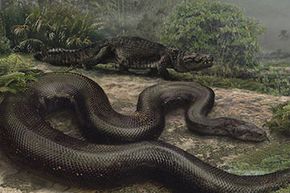Plunge the chasm of human mythmaking and you'll encounter lots of colossal snakes, from cosmic world serpents to malevolent monsters. Today, their fictional descendants continue to enthrall us, whether trying to swallow Mowgli from "The Jungle Book" or simply vomiting up a half-digested Jon Voight in 1997's "Anaconda."
But outside the world of myth and fantasy, what colossal specimen can science offer us? What, based on fossil evidence and biological survey, is the largest snake ever to slither its way through the natural world?
Advertisement
The modern serpent queen's crown (the females are larger in both species) rests most easily on the heads of either the Asian reticulated python (Python reticulatus), so called for its geometric color pattern, or the South American green anaconda (Eunectes murinus). If you're an avid reality TV viewer, you might remember the green anaconda Chumana, which failed to gobble up "Eaten Alive" host Paul Rosolie.
Many sources tend to credit the reticulated python with the greatest record length, while crediting the heavier, semiaquatic green anaconda with the greatest overall weight and size as the biggest snake in the world. Other sources, such as the Smithsonian National Zoological Park, just go ahead and award the green anaconda top honors. You might well expect there to be a bit more scientific certainty on the matter, but you'd be quite wrong.
Giant snake accounts are rather like giant fish stories. The maximum size is directly proportional to the amount of skepticism you choose to employ. Do you trust that Victorian explorer or scrap of local hearsay? Do you ignore how stretched the skin appears in that 50-year-old photograph? Ultimately, record measurements in the wild are few, far between and easily bungled or exaggerated.
For instance, an alleged 33-foot (10.1-meter) reticulated python from a 1946 Natural History Magazine story continues to pop up in articles on giant snakes, though herpetologist John C. Murphy dismisses this and any wild P. reticulatus length greater than 25 feet (7.6 meters). Meanwhile, field measurements in a 1999 survey averaged a little under 12 feet (3.2 meters) in the jungles of southern Sumatra, maxing out at just shy of 20 feet (6.1 meters) [source: Shine et al.].
But please, go ahead and believe H.N. Ridley's 1899 mention of "a specimen measuring 40 feet having been reported as obtained by a scientific expedition in Manila" if you crave size over documentation.
And then there's the green anaconda. According to German herpetologist Lutz Dirksen, the larger females typically reach lengths of 9 feet (2.7 meters) and weigh upward of 200 pounds (90.7 kilograms). Dirksen cites a record 29-foot (8.8-meter) E. murinus account, while Murphy entertains the possible reliability of up to 32-foot (9.8-meter) measurements.
But again, leave your skepticism on the nightstand and you can revel in Fritz W. Up de Graff's dubious 1923 account of a 50-60 foot (15-18 meter) green anaconda [source: Murphy].
Either way you shake the reputable data, however, the green anaconda wins the heavyweight title. With its mass suspended in its watery habitat, this apex predator can hit the scales at 441 pounds (200 kilograms) -- a good 100 pounds (30 kilograms) heavier than most of the largest reported pythons [source: Dirksen].
They're both huge serpents -- and their size has everything to do with their tropical homes. Remember, these are cold-blooded reptiles we're talking about here. The maximum size for either species is determined by both ambient environmental temperature and metabolic rate, in addition to a steady diet of things to swallow whole.
And so to find a larger snake, we have to turn up the heat and venture into even steamier jungles on an ancient Earth. Sixty million years ago you'd find just such a tropical hell in the Cerrejon rainforest, located in modern-day Colombia. We're talking average yearly temperatures of 86-93 degrees Fahrenheit (30-34 degrees Celsius), far hotter than modern tropical rainforest temperatures [source: Head].
Here, Titanoboa (Titanoboa cerrejonensis) made its home, feasting on equally giant turtles and crocodiles in the oldest known American rainforest. By comparing the creature's fossilized vertebrae to existing snake specimens, University of Florida paleontologists estimate its tip-to-tail length at a whopping 42 feet (13 meters) and its crushing weight at more than a ton.
Certainly, there's room enough for larger serpents in the shadows of prehuman history, but for now Titanoboa reigns supreme as King of Serpents and the largest snake ever to slink its way through the jungle.
Advertisement



